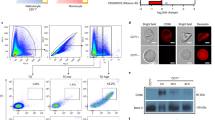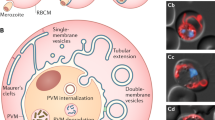Abstract
TRAFFICKING pathways in malaria-infected erythrocytes are complex because the internal parasite is separated from the serum by the erythrocyte and parasitophorous vacuolar membranes1. Intraerythrocytic Plasmodium falciparum parasites can endocytose dextrans, protein A and an IgG2a antibody. Here we show that these macromolecules do not cross the erythrocyte or parasitophorous vacuolar membranes, but rather gain direct access to the aqueous space surrounding the parasite through a parasitophorous duct. Evidence for this structure includes visualization of membranes that are continuous between the parasitophorous vacuolar and erythrocyte membranes, and surface labelling of the parasite with fluorescent macromolecules under conditions that block endocytosis. The parasite can internalize by fluid-phase endocytosis macromolecules from the aqueous compartment surrounding it. Thus, surface antigens on trophozoites and schizonts should be considered as targets for antibody-directed parasiticidal agents.
This is a preview of subscription content, access via your institution
Access options
Subscribe to this journal
Receive 51 print issues and online access
$199.00 per year
only $3.90 per issue
Buy this article
- Purchase on Springer Link
- Instant access to full article PDF
Prices may be subject to local taxes which are calculated during checkout
Similar content being viewed by others
References
Aikawa, M., Miller, L. H., Johnson, J. & Rabbege, J. J. Cell Biol. 77, 72–81 (1978).
Hsiao, L., Howard, R. J., Aikawa, M. & Taraschi, T. F. Biochem. J. 274, 121–132 (1991).
Hunter, J. A., Hurtley, S. M., Murray, M. & Taraschi, T. F. Biophys. J. 59, 442a (1991).
Kuismanen, E. & Saraste, J. Meth. Cell Biol. 32B, 257–273 (1989).
Grellier, P., Rigomier, D., Clavey, V., Fruchart, J.-C. & Schrevel, J. J. Cell Biol. 112, 267–277 (1991).
Swanson, J. A., Yirinec, B. D. & Silverstein, S. C. J. Cell Biol. 100, 851–859 (1985).
van der Schaft, P. H. et al. Biochim. biophys. Acta 901, 1–14 (1986).
Howard, R. J. et al. J. Cell Biol. 103, 1269–1277 (1986).
Howard, R. J. et al. J. Cell Biol. 104, 1269–1280 (1987).
Taylor, D. W. et al. Molec. Biochem. Parasitol. 25, 165–174 (1987).
Rodriguez, M. & Jungery, M. Nature 324, 388–391 (1986).
Elford, B. C., Haynes, J. D., Chulay, J. D. & Wilson, R. J. M. Molec. Biochem. Parasitol. 16, 43–60 (1985).
Jepsen, S. Scand. J. Immun. 18, 567–571 (1983).
Jensen, J. B., Boland, M. T. & Akood, M. A. Science 216, 1230–1233 (1982).
Green, T. J. et al. Am. J. Trop. Med. Hyg. 34, 24–30 (1985).
Trager, W. & Jensen, J. B. Science 193, 673–675 (1976).
Barnwell, J. W. Blood Cells 16, 379–395 (1990).
Author information
Authors and Affiliations
Rights and permissions
About this article
Cite this article
Pouvelle, B., Spiegel, R., Hsiao, L. et al. Direct access to serum macromolecules by intraerythrocytic malaria parasites. Nature 353, 73–75 (1991). https://doi.org/10.1038/353073a0
Received:
Accepted:
Issue Date:
DOI: https://doi.org/10.1038/353073a0
This article is cited by
-
Plug for the parasitophorous duct: a solution of two conundra
Malaria Journal (2020)
-
Human plasma plasminogen internalization route in Plasmodium falciparum-infected erythrocytes
Malaria Journal (2020)
-
The parasitophorous vacuole of the blood-stage malaria parasite
Nature Reviews Microbiology (2020)
-
Nanomedicines for Malaria Chemotherapy: Encapsulation vs. Polymer Therapeutics
Pharmaceutical Research (2018)
-
Assessment of Anti-Plasmodial Activity of Non-Hemolytic, Non-Immunogenic, Non-Toxic Antimicrobial Peptides (AMPs LR14) Produced by Lactobacillus plantarum LR/14
Drugs in R&D (2014)
Comments
By submitting a comment you agree to abide by our Terms and Community Guidelines. If you find something abusive or that does not comply with our terms or guidelines please flag it as inappropriate.



